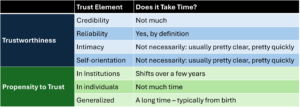Five Misconceptions about Trust in Business: Part 2
In this blog series, we explore five of the most common misconceptions about trust that, while they are widely-held, are powerful inhibitors to creating real trust:
- Trust has to be earned
- Trust takes time to grow and is quickly lost
- Clients just want you to solve their problem
- Clients will trust you if you give good advice
- Having the right answer is critical
 MISCONCEPTION 2: TRUST TAKES TIME TO GROW AND IS QICKLY LOST
MISCONCEPTION 2: TRUST TAKES TIME TO GROW AND IS QICKLY LOST
Trust takes a long time to build, and only a few moments to be destroyed. That has to be one of the greatest trust platitudes, and it is as wrong as it is commonly believed.
Trust takes a long time to build? Not necessarily, in fact frequently not.
Trust takes only a few moments to be destroyed? Even less true.
The Truth
Of course, platitudes don’t achieve that status out of thin air. There’s usually something to them, and of course there’s something here too.
Let’s start with the first part: trust takes time. As we explored in Part 1 of this blog, most of the time we start off even new relationships with at least a limited amount of trust. But there are two points to consider when examining how long trust takes to build: the trustworthiness of the person seeking to be trusted, and the propensity to trust of the person from whom we are seeking trust.
The Trust Equation breaks down trustworthiness into four discrete factors: Credibility, Reliability, Intimacy, and Self-orientation. Of these, Reliability is the only factor that requires the passage of time to be evaluated: you need to set an expectation, then follow through on it. And even then, it’s really more about the number and consistency of interactions than the amount of elapsed time.
The other element is what social scientists and trust academics call “generalized” trust—the propensity to believe well of the motives of strangers, and to be generally optimistic about the future. That one, it turns out, can take ages to turn around—negatively or positively. As Dr. Eric Uslaner points out, generalized trust is installed early, and usually remains stable throughout our lives.
So, does trust take time or not? The answer is, “it depends.” And what it depends on is the type of trust we’re talking about. Let’s break it down:

Now let’s look at the second part: trust is quickly lost. Most relationships, like most emotions, take roughly as long to get over as they took to develop. Marriages or friendships don’t end overnight. There may be a flash point, a straw that breaks the camel’s back. But we usually give people we trust the benefit of the doubt. We don’t dump them abruptly the first time things get difficult.
Most examples of “trust lost quickly” turn out to be either just the last drip in a long series of drips eroding trust, or a delusion about trust’s existence in the first place (you don’t “violate the trust” of a subscriber to your email list by sending them a worthless referral; the relationship you have with a name on your email list may be many things, but “trust-based” is probably a stretch).
Trust formed quickly can be lost quickly; trust formed at a shallow level can be lost at the same level. But trust formed deeply takes deeper violations, or a longer time, to be lost.
But, you might say, so what? Why is that harmful? What’s the big deal?
The Harm
If you believe that trust takes a long time to build, then you likely believe that it also takes sustained effort, and that there are limited opportunities to build trust when you have limited time. You are inclined to focus only on those things that bring immediate gratification, like solving the problem or delivering the solution (Credibility and Reliability, which are shallow forms of trust). You are less likely to be vulnerable and take risks to connect at a human level, and less likely to set aside your own goals (Intimacy and Self-orientation, which create deeper personal trust).
If you believe that trust can be lost in a moment, then you likely believe you must be cautious and careful about protecting it. You are likely to think about trust as a precious resource to be guarded against being tarnished. You are inclined to institute rules and procedures to protect it and to give cautionary lectures about the risk of losing trust.
These beliefs are self-defeating. Why would you expend energy on something for which you are not likely to see results quickly, or at all? Or that you could lose in just a moment?
And they lead to precisely the kinds of behavior that result in trust lost.
Trust, at a personal level, is like love and hate: you tend to get back what you put out. You empower what you fear. Those afraid of getting burned are the most likely to get burned. Fear of trust not only doesn’t save trust – it actually causes low trust.
Trust is a Muscle
Thinking of trust as something that takes a long time to build makes you unwilling to invest in it, and thinking of trust as something you can lose in a minute makes you cautious and unlikely to take risks. But the absence of risk is what starves trust. There simply is no trust without risk – that’s why they call it trust.
If your people aren’t empowered, if they’re always afraid of being second-guessed or saying the wrong thing, then they will always operate from fear and never take a risk – and as a result, will never be trusted.
Trust is a muscle – it atrophies without use. And the repetition of the mantra “trust takes time to build and can be lost in a moment” just tells people not to use it.
Turns out the stupidest trust is the trust you never engaged in because you were unwilling. The smartest trust is the trust you create by taking a risk.
UP NEXT – Come back tomorrow to read about the third misconception: Clients just want you to solve their problem.
Trust-Based Resources to Maximize Your Team’s Potential:
- Join the crowd and sign up for one of our Public Virtual Workshops.
- Subscribe to our newsletter.
- Build trust on your terms through our Self-Paced Online Courses.
- Follow us on LinkedIn or X.
- Contact us directly to explore workshops for your organization.

Trackbacks & Pingbacks
[…] UP NEXT – Come back tomorrow to read about the second misconception: Trust takes time to build and is quickly lost. […]
Leave a Reply
Want to join the discussion?Feel free to contribute!